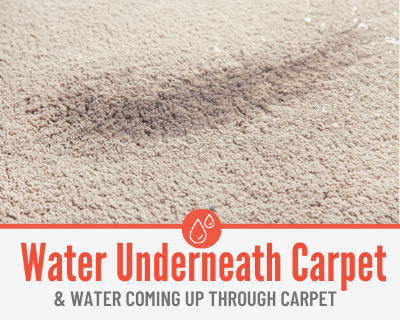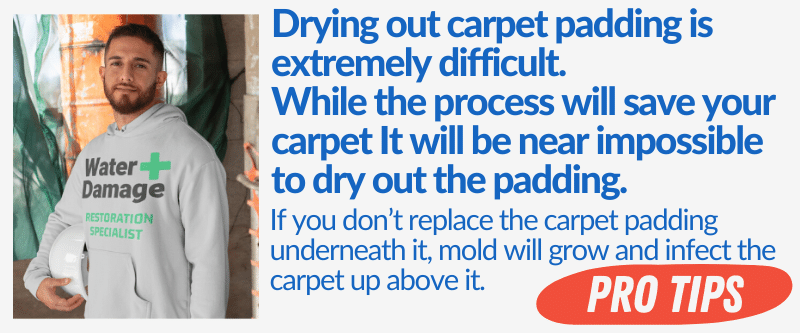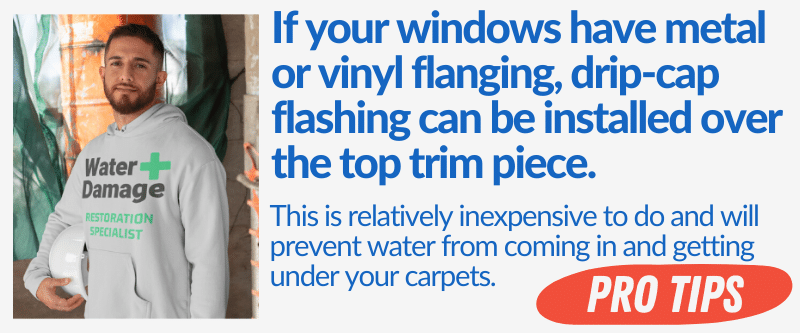Water coming up Through Your Carpet? Not sure why There is Water Underneath your Carpet?
In this guide you will learn:
- How to Identify the Cause of Water Underneath Carpet in the basement or 2nd floor,
- How to Tell if Water under your Carpet is due to Foundation Leaks,
- What to do About Water Coming up Through Your carpet & How to Deal with water damage under the carpet.
- Causes for Water under your carpet During Heavy Rain.

In this comprehensive guide, we’ll go over ways to troubleshoot common causes for water coming up through your carpet, and what to do about it.
Why is there Water Coming up Through my Carpet?
Water coming up through your carpet can happen for a number of reasons, but most commonly occurs when there’s a foundation leak.
Foundation leaks can cause serious damage over time and compromise the structural integrity of the very foundation of your home, so you should deal with them immediately.
When the soil beneath your home shifts, it can cause foundation leaks to occur.
The concrete that your home sits on moves, which can cause it to crack and can damage pipes or plumbing which results in water leaking up through the slab and pooling under your carpet.
The majority of homes have copper water lines near their foundation, which may start leaking as a result of normal wear and tear.
Cold weather could also lead to them bursting, which could leak up through the slab as well if the concrete has already cracked, and would likely be the root cause of water coming up through the carpet.
How to tell if there is Water Under your Carpet due to a Foundation Leak
While water coming up through your carpet is one of the tell-tale signs of a foundation leak, there are other ways of verifying it.
Like with all water damage, time is of the essence, so if you suspect a foundation leak is the main source of why there is water underneath your carpet – you’ll want to act quickly.
Foundation leaks can be particularly devastating in terms of the damage they cause, so all the more reason to identify them as soon as possible.
Mold growing its way up your walls due to water under your carpets can be a good indicator of a foundation leak. Water seeping up in through the carpet floor can wick its way up the walls, and mold loves damp environments to grow in.
If you spot mold that starts on your floor and works its way up the wall, likely accompanied by a damp, musty smell from your wet carpet, there’s a good chance you have a foundation leak.
Another good indicator is an unusually high water bill without any changes to your normal water usage. If pipes have burst and are continually leaking, you will see a spike in your home’s water usage.
That paired with the sudden occurrence of low water pressure throughout your home are likely resulting from a foundation leak, and will require immediate attention.
Water Coming Up Through Carpet?
Call 844-488-0570 for a Risk Free estimate from a Licensed Water Damage Restoration Specialist in your area.
We Can Help Pinpoint the Cause of Water under your Carpet, Dry out your Carpets & Fix the Cause.
What to Do About Water Coming up Through your Carpet
First and foremost, if the water is coming up through your carpet due to a burst or leaking pipe in your foundation, you’ll want to shut off the main source of water in your home.
The main water valve can typically be found within three to five feet of where the water enters your home, but sometimes it can be found along the front wall of your home or even near a hot water heater or furnace.
The next thing you’ll want to do is get in contact with a professional plumber.
Foundation leaks are major issues within a home, and while there are ways of temporarily fixing normal leaks yourself, in this case it really is best left to the experts.
Once you’ve got the water shut off to your home and contacted a professional, you should start drying out your carpet as soon as you can, ideally within 48 hours.
This will make it far less likely that a serious damage will occur, such as mold under your wet carpet or rusting pipes.
But for now, the basics are as follows:
• Absorb up as much water as you can beforehand from your wet carpet, with towels, mops, and wet vacuums
• Set up high powered fans and dehumidifiers, and use multiples of each if you’re able
• Leave fans and dehumidifiers on highest settings, and be sure to empty dehumidifiers as needed
• Open windows if possible, to allow for better air circulation in the room where the carpet with water underneath it is.
• Be patient, and don’t rush the process
See our guide here: How to Dry Wet Carpets With Fans
Getting set up and getting your carpets dried out as soon as the water is detected could save you thousands in damage repairs, or even from having to replace your subflooring entirely.
You’ll also want to remain vigilant for any signs of mold growth under your wet carpet , as mold poses a major health risk and will need to be addressed immediately.
One unfortunate thing, however, is that your carpet padding will most likely need to be replaced. There’s just no way around it for large prolonged leaks.

If you do not replace carpet padding or dry it out for small leaks,mold growth is almost certain.
Once that happens, your carpet will need to be replaced as well, so again you’ll need to take swift action to save your carpet.
Read our Guide: How to Dry out Wet Carpet Padding
Water Coming up Through Carpet on Second Floor
If you’re noticing water coming up through your carpet on the second floor of your home, the culprit is almost guaranteed to be one of two things.
The first is that a pipe running through the flooring underneath your carpet has sprung a leak. That, or it has completely burst, depending on if there’s a significant portion of water.
The second, and more likely scenario of the two, is that water isn’t “coming up through your carpet” at all, but rather you have a roof leak.
A foundation leak wouldn’t be able to reach your second floor, nor would rain water be able to pool nearby, so it would be physically impossible.
Common indicators of a ceiling leak are sagging ceilings, stains on your ceiling, and the unpleasant aroma of stagnant, accumulated water. Cracks or paint chipping away are also telltale signs.
If you find you have a roof leak, you’ll want to get in contact with a roofer or contractor right away, because if left alone roof leaks can cause major structural damage to your home, and could potentially cave in causing serious or even fatal injury.
Water Under Carpet During Heavy Rain
Water coming up through your carpet during or after heavy rainfall can occur for several reasons.
If it’s occurring on the second floor, as mentioned above you likely have a roof leak and should get in contact with a professional to have your roof inspected.
If it’s on the first or basement floor, however, that is likely one of two things.
Next time it rains, step outside (providing it’s safe to do so) and look around the side of your house where the room with water in the carpet is.
Check to ensure that water is being properly drained away from the side of your home.
If you see water pooling or puddling along the side of your home, the water is likely seeping into the slab foundation that way, and over time is wicking up into the carpeting.
The other cause could be bad flashing on a door or even windows. Check the cracks and seams of any doors and windows in the room experiencing water coming up through the carpet, and watch for any signs of water getting through.

What to do about Water Damage Under the Carpet
In some instances, water damage to homes is covered by your insurance, usually in the case of bursting pipes. Most homeowners don’t carry flood insurance, so if you’ve experienced flooding damage, unfortunately you may be stuck with the repair bill.
If you’re unsure what is and isn’t covered, you should contact your insurance provider and find out what their policy is on water damage to your home in case of water under your carpet, and the ways in which you are covered.
That being said, if the water damage on your carpet isn’t too severe, you can attempt to address it yourself.
With wet carpets, mold is going to be one of the greatest concerns, as damp carpet is one of the most ideal environments for mold and mildew to flourish.
An unfortunate downside to carpeted flooring is that they do a wonderful job of hiding water damage, so its crucial that you inspect your flooring carefully and remain vigilant any time there’s a leak or moisture that gets through.
Replacing carpeting can be expensive, but its not as expensive as replacing the carpeting, replacing the subflooring, and hiring a mold specialist all at the same time.
At the first sign of water, you’ll want to get the carpet dried out as quickly as you can. Wet vacuums are a great starting point, as they’ll help remove most of the surface moisture from the get-go.
Using towels to wick out any moisture out of your wet carpet is another option, although it will require more work and will take longer.
Any furniture, rugs, or other items in contact with the wet areas of the carpet should be moved away, or off of it entirely if possible.
Next, you’ll want to get air circulating through the room, and it is strongly recommended you use dehumidifiers in this instance, now more than ever.
Since carpeting is going to be the most water-absorbent of all flooring types, you’ll need dehumidifiers to help pull that moisture out, and you’ll want to keep fans running on high settings at all times to aid the drying process.
Empty your dehumidifiers often to ensure they continue running, and if you’re able crack your windows open to let air flow through the room, provided it isn’t more humid outside than it is inside.
Water Damage Under your Carpets?
Call 844-488-0570 for a Risk Free estimate from a Licensed Water Damage Restoration Specialist in your area.
We Can Help Dry out & Repair any Water Damage due to Water Getting under your Carpets.
How to help Prevent Mold due to Water Underneath Carpets
Any time water gets under carpet, you’re going to notice a damp, musty smell.
Before you treat the smell of your wet carpet, it is important you dry the carpet out as best you can, otherwise it will only continue to persist.
The process could take several days, and if at any point you start to notice mold growing up the sides of your walls or in the carpet itself, it’s time to call a mold removal specialist.
Once the carpets are dry, and you’re confident there isn’t any serious mold growth, you can treat the smell by combining a cup of vinegar with two cups of warm water, and lightly misting the area with a spray bottle.
It’s important not to become overeager with your light misting, however, as doing so could put too much moisture back into the carpet and set you back to square one.
Using baking soda or carpet freshening powders, which are dusted over the carpet and vacuumed up, can also help remove any lingering odors that remain in your carpet.
If after following these steps for several days the musty smell persists, don’t delay any further. Contact a mold removal specialist, and start making plans to have your carpeting replaced.
Mold can pose serious health risks to you and your family, particularly those who suffer from conditions such as COPD or asthma.
When To Call a Professional
If at any point you experience flooding in your home and water under your carpets, or if you ever feel overwhelmed or in over your head, its time to contact a professional.
Attempting to do it yourself can be a great way to save money, but water damage specialists have tools and training to help them assess and remedy situations you may not even be aware of.
When it comes to water damaged carpets, the longer you wait to act, the longer the water stays in contact with your carpets and flooring, leading to increasing water damage issues as well as the possibility of pests such as mosquitos making themselves at home.
If you find yourself in a situation where you’re unable to address the water leaks coming up through carpet yourself in a timely fashion, calling in a professional would be a much better alternative than leaving it until you’re able to get around to it.
We have Water Damage Restoration Technicians that can help Find the Source of Water Under your Carpet , Dry your Carpets and Fix the Cause of it.
For Disasters of all Sizes,available in 95% of the USA
